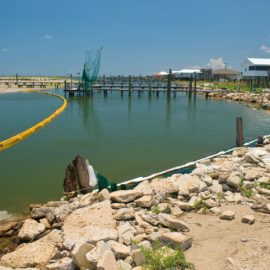
“I hope that I can raise this one, but I don’t know,” he said. “That’s a long, drawn-out process.”
Hurricane Ida demolished some of the air monitors at refineries so the EPA is trying to continue the readings.
As the electrical grid smashed by Hurricane Ida comes back to life and industrial plants fire up again, federal regulators began assessing the air pollution Thursday at five sites in southeast Louisiana. Ida knocked out power to more than 1 million electricity customers in the state, including much of the industrial corridor along the Mississippi River between New Orleans and Baton Rouge. With power returning, the big plants have been running flares and other smokestacks to restart operations, raising concern about a big pulse of air pollution at a time when 15 of the state’s air monitors are out of commission. The U.S. Environmental Protection agency said it has installed monitors at the Shell oil refinery in Norco, the Denka Performance Elastomer plant in Reserve, the Marathon refinery in Garyville, at a state site in the Irish Channel in New Orleans and at Port Fourchon. Though down 15 permanent monitoring stations, the state Department of Environmental Quality had already stationed mobile monitors at the Shell refinery and at the Chalmette and Valero refineries and other petrochemical plants in St. Bernard Parish. State environment officials say dark, sooty flaring shouldn’t be a cause for alarm because the flares were likely combusting almost all of the pollutants.
nola.com
The state looks through rose colored glasses. The EPA sees a worry.
EPA officials said its community-based monitoring will measure volatile organic compounds that can cause harmful smog. They are a common emission from petrochemical plants. The monitors will also measure minute airborne dust and other particles, which are known to cause respiratory and other health ailments with long-term exposure. Earlier this month, the agency also began flying sorties with an airplane designed to collect real-time air emissions data. The craft has completed flights over 60 industrial sites, officials said. The EPA is also restarting chloroprene community air monitors around Denka. EPA has been measuring emissions of chloroprene, a likely carcinogen, for several years and operating a continuous monitoring system since 2020. EPA officials said those monitors were secured before Ida made landfall to prevent damage. In the mid-2010s, EPA determined chloroprene was a likely carcinogen, making the area around Denka have the highest cancer risk in the United States from airborne pollution and sparking outrage from neighbors. Industry groups have challenged that finding, while environment advocates and community groups have pressed for tighter air controls. Regular emissions data have played an important role in that debate.
There are sites were these monitors can be read:
More information about the Denka chloroprene monitors can be found at https://www.epa.gov/la/laplace-louisiana-background-information. Data from the EPA community monitoring sites will be available within 10 days at EPA’s website: https://response.epa.gov/HurricaneIda. Data from the EPA plane, known as Airborne Spectral Photometric Environmental Collection Technology, is available at the same EPA Ida response page.
The EPA is working for us as opposed to the state. Maybe the state LDEQ needs a wake up call!



